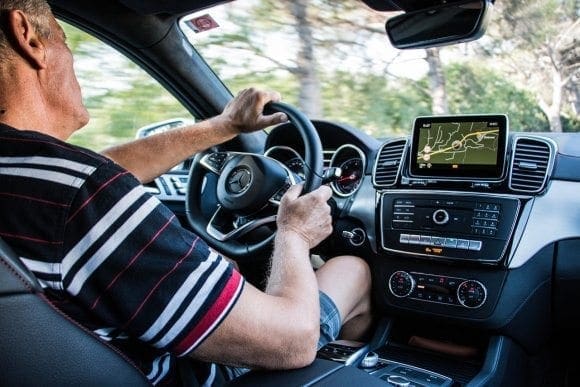El Paso, TX. Chiropractor Dr. Alex Jimenez takes a look at driving and how it effects the spine.
Daily, nearly 90% of journeys and 92% of miles traveled are made in autos or ground transportation (buses, trucks). On average, guys drive 44 miles as well as girls drive 34 miles each day. For many Americans, driving a motorized road vehicle is their job: truck drivers, bus drivers, ambulance and fire trucks, police, taxis etc.
Modern car and truck layouts have come a long way in their own design over the past 20 years, with better fuel efficiency, better features, better styling and better relaxation. But is there any signs that the look of contemporary bus, car or truck seats and driving might play a part in causing a few of the back injuries that plague�Americans each year?

Contents
Exactly Why Is Driving Different To Ordinary Sitting?
In case your own car is not moving, then sitting in a driving seat probably isn’t substantially different to sitting in a chair that is cushioned, but as soon as the vehicle begins moving things change. Additionally, when driving the feet are actively being used, the right foot on the gas (accelerator) pedal, the left on the brake, and in a stick-shift also on the clutch. When the feet are active they can’t be utilized to support and stabilize the reduced body when they’re put on the floor during regular sitting in a chair, as usually occurs. There is evidence the blend of those variables, coupled with the look of the car seat itself, can increase the possibility of back problems for many people.
Is Driving Linked With Back Problems?
Lab studies have examined the effects of whole-body vibration when a person is sitting in a car seat. The lumbar spine has a natural resonant frequency of 4-5 Hz , and results show that this natural frequency can be excited by lab simulated vehicle driving, and this may result in high spinal loadings in the lower back, and also this in turn could result in greater postural distress and an increased hazard of low back pain and injury.
Quite a few research studies have investigated potential associations between back and driving problems, and usually these studies have found significant consequences.
Drivers in the USA and in Sweden found that in each country 50% of those questioned reported low back pain.�
Investigation of the potential reasons for this revealed that long term vibration exposure from driving was among the greatest risk factors for neck, back and low back problems.
Gender generally seems to play an important part in the possibility of developing driving-related back problems. A survey of over 7000 Parisians found that even though severity and the prevalence of low back pain was higher in women, driving was just connected with back problems in guys. The need for driving as a risk factor improved with driving time, and was especially important for guys who drove 4 hours or more each day.
A survey of over 1400 urban transportation system motorists showed that issues using the capacity to accurately adjust the seat that was driving have significant effects on the prevalence of low back problems.
Nevertheless, it appears that driving need not consistently raise the chance of back problems.
Is There An Ideal Car Seat Layout?
Based on a comprehensive evaluation of advice from peer-reviewed scientific journals and texts, automotive engineering reports, and also the National Library of Medicine a string of requirements for the best car seat layout have been developed. Ideally, the optimal car seat should have:
1. Adjustable seat back incline (100 degrees from horizontal is ideal)
2. Changeable seat bottom depth (from seat back to front edge)
3. Adjustable seat height
4. Flexible seat bottom incline
5. Seat bottom cushion with solid (dense) foam
6. Adjustable lumbar support (horizontally and vertically adjustable)
7. Depth pulsating lumbar support to lessen static load
8. Flexible bilateral arm rests
9. Flexible seat back incline (100-degrees from horizontal is optimal
10. Flexible head restraint with pad that is lordosis
11. Frequencies between 1- 20 Hz to dampen
12. Linear front-back seat traveling to allow otherwise sized drivers to reach the pedals
13. Seat back damped to reduce bouncing of the torso in rear end impacts
Driving Safety
What To Check For In A Great Car Seat Layout When You Buy The Next Car
It is likely that most automobiles available on the market today won’t have the features listed above that are desirable in the optimal car seat all, but some will have more than others pick wisely. Pay close focus on the subsequent 5 guidelines which should help you to protect your back when you drive.
1) Car Seat Comfort
You’ve fixed this to suit your body and when you sit in the car seat does it feel comfortable. Otherwise, you will be most likely caused by then the car seat rear discomfort issues should you drive for any length of time. Rebound up and down in the seat to find out the way that it adapts vibration. Take the automobile on a test drive.
2) Car Seat Adjustments
Can you correct each of the features of the car seat you want to adjust? At a minimum you need to have the ability to adapt:
- Seat space to accommodate different leg lengths
- Seat height to accommodate different leg lengths
- Backrest angle to sit down in either an upright or more reclined posture
You Should�Look For Other Adjustments That Are Useful:
- Seat tilt to angle the front of the seat down or up so that this does not press against the back of your knees
- Look for a car seat that supplies you with great low back support that can be corrected for depth (frequently the seat has an inflatable cushion) and is height adjustable
- Headrest for neck support
- Arms rests which are broad, cushioned and comfortable, and preferably height flexible
3) Shift Your Position
Remember to go your position from time to time. Wait until driving conditions are right to enable you to wriggle in the seat to relieve postural fatigue.
4) Take Breaks
Driving is exhausting work and to prevent driver fatigue and minimize postural discomfort it is good move around and take to pretty frequent rest breaks that enable you to stand up.
You can select a number of car seat accessories that will enhance seat comfort for you personally, from fleece covers to soften the seat to bead backrests to provide for some type of back massage while you drive. Select anything you find adds to your driving comfort.
5) Seat Accessories
You’re able to pick a number of car seat accessories which will improve seat comfort for you personally, from fleece covers to soften the seat to bead backrests to provide for some sort of back massage while you drive. Choose anything you locate adds to your driving comfort.
General Disclaimer, Licenses and Board Certifications *
Professional Scope of Practice *
The information herein on "Driving & Back Care" is not intended to replace a one-on-one relationship with a qualified health care professional or licensed physician and is not medical advice. We encourage you to make healthcare decisions based on your research and partnership with a qualified healthcare professional.
Blog Information & Scope Discussions
Welcome to El Paso's Premier Wellness and Injury Care Clinic & Wellness Blog, where Dr. Alex Jimenez, DC, FNP-C, a Multi-State board-certified Family Practice Nurse Practitioner (FNP-BC) and Chiropractor (DC), presents insights on how our multidisciplinary team is dedicated to holistic healing and personalized care. Our practice aligns with evidence-based treatment protocols inspired by integrative medicine principles, similar to those on this site and on our family practice-based chiromed.com site, focusing on naturally restoring health for patients of all ages.
Our areas of multidisciplinary practice include Wellness & Nutrition, Chronic Pain, Personal Injury, Auto Accident Care, Work Injuries, Back Injury, Low Back Pain, Neck Pain, Migraine Headaches, Sports Injuries, Severe Sciatica, Scoliosis, Complex Herniated Discs, Fibromyalgia, Chronic Pain, Complex Injuries, Stress Management, Functional Medicine Treatments, and in-scope care protocols.
Our information scope is multidisciplinary, focusing on musculoskeletal and physical medicine, wellness, contributing etiological viscerosomatic disturbances within clinical presentations, associated somato-visceral reflex clinical dynamics, subluxation complexes, sensitive health issues, and functional medicine articles, topics, and discussions.
We provide and present clinical collaboration with specialists from various disciplines. Each specialist is governed by their professional scope of practice and their jurisdiction of licensure. We use functional health & wellness protocols to treat and support care for musculoskeletal injuries or disorders.
Our videos, posts, topics, and insights address clinical matters and issues that are directly or indirectly related to our clinical scope of practice.
Our office has made a reasonable effort to provide supportive citations and has identified relevant research studies that support our posts. We provide copies of supporting research studies upon request to regulatory boards and the public.
We understand that we cover matters that require an additional explanation of how they may assist in a particular care plan or treatment protocol; therefore, to discuss the subject matter above further, please feel free to ask Dr. Alex Jimenez, DC, APRN, FNP-BC, or contact us at 915-850-0900.
We are here to help you and your family.
Blessings
Dr. Alex Jimenez DC, MSACP, APRN, FNP-BC*, CCST, IFMCP, CFMP, ATN
email: coach@elpasofunctionalmedicine.com
Multidisciplinary Licensing & Board Certifications:
Licensed as a Doctor of Chiropractic (DC) in Texas & New Mexico*
Texas DC License #: TX5807, Verified: TX5807
New Mexico DC License #: NM-DC2182, Verified: NM-DC2182
Multi-State Advanced Practice Registered Nurse (APRN*) in Texas & Multi-States
Multi-state Compact APRN License by Endorsement (42 States)
Texas APRN License #: 1191402, Verified: 1191402 *
Florida APRN License #: 11043890, Verified: APRN11043890 *
License Verification Link: Nursys License Verifier
* Prescriptive Authority Authorized
ANCC FNP-BC: Board Certified Nurse Practitioner*
Compact Status: Multi-State License: Authorized to Practice in 40 States*
Graduate with Honors: ICHS: MSN-FNP (Family Nurse Practitioner Program)
Degree Granted. Master's in Family Practice MSN Diploma (Cum Laude)
Dr. Alex Jimenez, DC, APRN, FNP-BC*, CFMP, IFMCP, ATN, CCST
My Digital Business Card
Licenses and Board Certifications:
DC: Doctor of Chiropractic
APRNP: Advanced Practice Registered Nurse
FNP-BC: Family Practice Specialization (Multi-State Board Certified)
RN: Registered Nurse (Multi-State Compact License)
CFMP: Certified Functional Medicine Provider
MSN-FNP: Master of Science in Family Practice Medicine
MSACP: Master of Science in Advanced Clinical Practice
IFMCP: Institute of Functional Medicine
CCST: Certified Chiropractic Spinal Trauma
ATN: Advanced Translational Neutrogenomics
Memberships & Associations:
TCA: Texas Chiropractic Association: Member ID: 104311
AANP: American Association of Nurse Practitioners: Member ID: 2198960
ANA: American Nurse Association: Member ID: 06458222 (District TX01)
TNA: Texas Nurse Association: Member ID: 06458222
NPI: 1205907805
| Primary Taxonomy | Selected Taxonomy | State | License Number |
|---|---|---|---|
| No | 111N00000X - Chiropractor | NM | DC2182 |
| Yes | 111N00000X - Chiropractor | TX | DC5807 |
| Yes | 363LF0000X - Nurse Practitioner - Family | TX | 1191402 |
| Yes | 363LF0000X - Nurse Practitioner - Family | FL | 11043890 |









